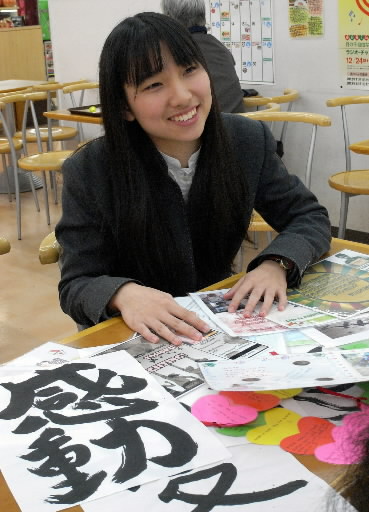Calligraphy and Poster exhibition, creating ties between youth in Japan and Indonesia, seeks to support Fukushima
Dec. 20, 2012
A project entitled “The Power of Calligraphy—Remembering the Earthquake,” which links youth in Hiroshima, Fukushima, and Indonesia in an effort to generate support for the people of Fukushima, continues to move forward. Exhibitions at these three locations are composed of calligraphy works and illustrated posters which have been created, and exchanged, among the participants.
The idea for the project was conceived in March of this year when The Youth Peace Ambassador Workshop was organized by the United Nations Educational, Scientific and Cultural Organization (UNESCO) Bangkok Office and other organizations, in Hiroshima and Etajima City. At this workshop the participants devised action plans for peace, and the current project involving calligraphy was among these action plans. The effort is the brainchild of Natsuki Ikeda, 18, a third-year student at AICJ High School in Asaminami Ward, Hiroshima and Mohammad Ridwan, 24, a university student in Indonesia, along with other participants.
From Indonesia, 68 posters on the theme of reconstruction from the Great East Japan Earthquake, produced mainly by high school and university students, were contributed for the project. The posters bear such images as rainbows and the sun, with messages written in Japanese.
A total of 23 works of Japanese calligraphy were offered from Fukushima through “Team Fukushima,” an NPO that Ms. Ikeda made contact with when she visited the city of Minamisoma during her spring vacation earlier this year. Another 12 works of calligraphy were contributed by students in Hiroshima who belong to the calligraphy club at AICJ Junior High and High School. These works were exhibited in the Hiroshima City Plaza for Town Development through Citizen Exchange, located in Naka Ward, from October 28 to November 1.
“Even if we donate money, it actually comes from our parents’ pockets. So I wanted to do something that students themselves could do,” Ms. Ikeda explained. “The project took a lot of hard work, but I’m happy that it’s pleased the people in Fukushima.” (Miyu Sakata, 17)
(Originally published on December 11, 2012)








